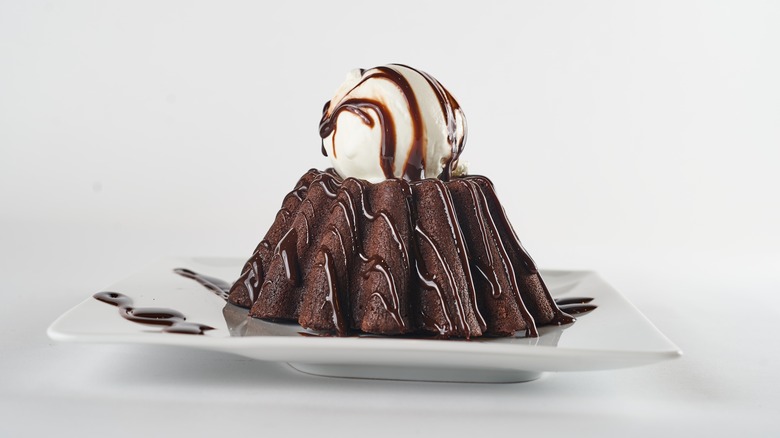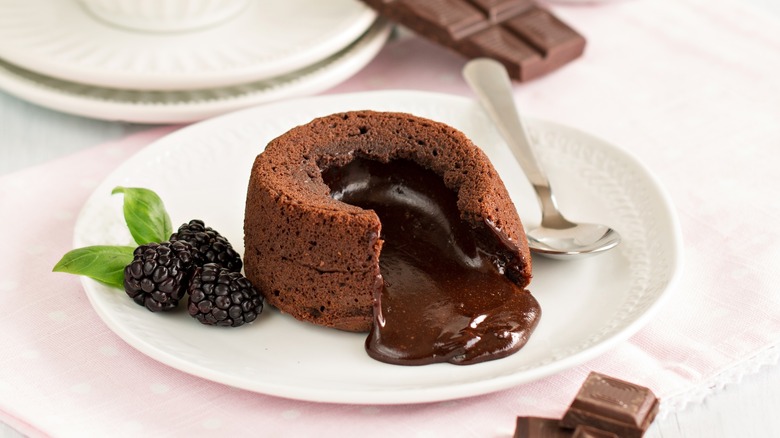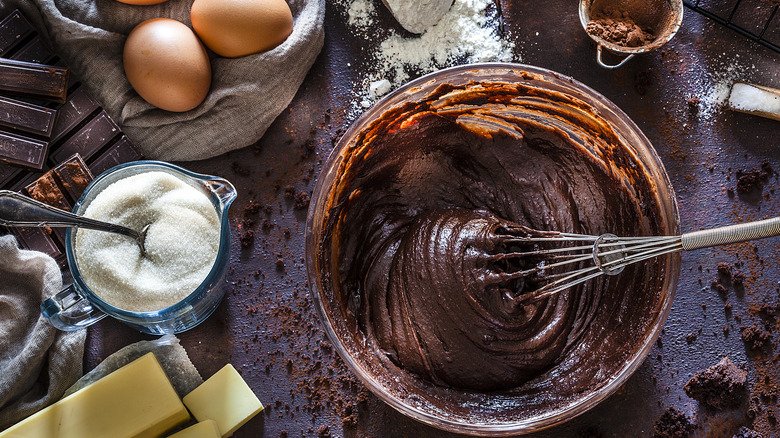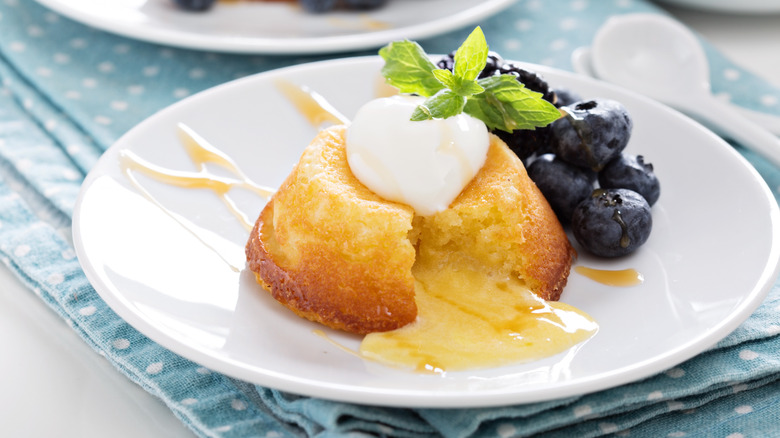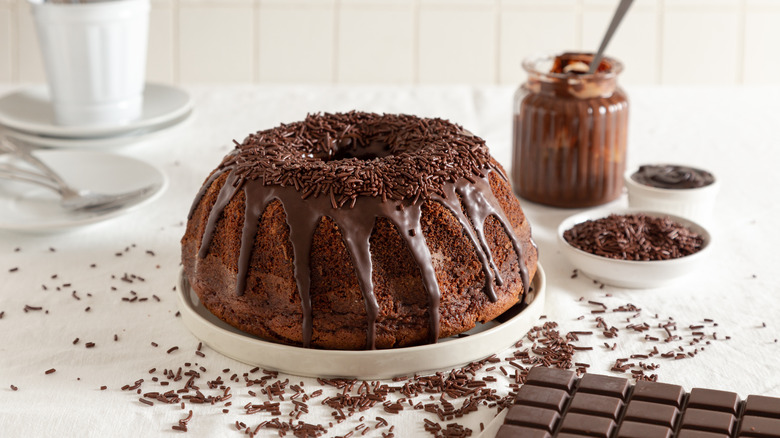What, Exactly, Is A Mi-Cuit Cake?
Some foodie idioms struggle to cross boundaries. The French phrase "mi-cuit," literally "half-cooked," or in a cake's case, "half-baked," doesn't come with the English connotations of unpreparedness or '90s stoner comedies. Used in a savory context, the classic sesame-crusted, seared-exterior, red-center tuna tataki would be mi-cuit tuna in French. If you apply the same idea of an appealing, undercooked center to a cake, you get a molten lava cake — the classic Valentine's Day dessert.
One way to achieve a properly molten center for your lava cakes is not to underbake the batter, but to insert a frozen puck of chocolate ganache into the center of the cake before baking. There are plenty of people, however, who prefer to make a cake that lives up to its name with strategically high temperatures and low cooking times; this creates a just-baked shell that will erupt at the merest suggestion of pressure.
This messy meal-ender pleases crowds, only uses five ingredients, and can even be gluten-free. Some say the mi-cuit cake has jumped the shark, which may be inevitable for a dish that's enjoyed such a prominent place on restaurant menus for several decades. But so many restaurants — from Jean-Georges to Domino's Pizza — can't be wrong. Plus, if you're bored with chocolate, there's a wide range of non-chocolate mi-cuit cakes to explore.
Mi-cuit cakes are made from just a few ingredients
Like many French classics, mi-cuit cakes use a small number of high-quality ingredients prepared simply and well, which allows their true flavors to shine. The best mi-cuit cakes, then, require the best chocolate. Valhrona, for example, is often associated with top-tier French pastry chefs, but more than any particular brand name, what matters is using the best chocolate possible. This is because the other ingredients — typically just butter (also of the highest possible quality), sugar, flour, and eggs — are only there to form the structure of the mi-cuit cake, the interplay of crisp crust and melting middle that makes these puddings what they are.
It's even possible to forego the flour and make your mi-cuit cake gluten-free. The flour content in the original recipe is negligible at less than a tablespoon per serving. It acts as a stabilizer and brings a bit of structure to the cake. If you want to make your mi-cuit cakes flourless, just ensure the eggs can provide that structure by whipping them to activate the albumen and incorporate as much air as possible.
The other two ingredients that come up in mi-cuit chocolate cake recipes are heavy cream and salt. Melting chocolate with hot heavy cream and then chilling to set is how good ganache is made for the "frozen puck" method, and high-quality salt has been many chocolatiers' not-so-secret weapon for years.
How mi-cuit cakes are made
The first step in making a mi-cuit cake is to create a buttery base by melting dark or white chocolate in a double-boiler. This step, though traditional, can also be accomplished using a microwave and a microwave-safe bowl to save time — and dishes.
This rich base is then sweetened with sugar and lifted with eggs that have been beaten until they've doubled in volume. While some bakers try to add extra lift by separating the egg whites and folding the airy albumen foam into the cake's base, as if preparing a mousse or souffle, this technique isn't widespread and doesn't seem to have any significant impact on the final product. If the baker is using flour, this is when they stir it in. The cake is then ready for the molds.
There are two ways to serve a mi-cuit cake: The safe way, in the mold, or for dramatic effect, turned out onto the plate. For unmolded cakes, the mold should simply be greased and lined with cocoa powder or brown sugar to ensure the cake doesn't stick to the sides when turned out.
The final step is to ensure the center stays liquid. This is either achieved by high heat and a short cooking time or by inserting a frozen center that will melt in the process. The classic chocolate center is a ganache, but time-pressed home cooks can substitute this for a few squares of dark chocolate instead.
Mi-cuit cakes don't have to be limited to dark chocolate
The major variations between mi-cuit chocolate cakes are whether or not there's flour in the batter, and whether the molten center is achieved by inserting ganache or deliberately underbaking the cake. However, mi-cuit cakes can come in many different flavors. Slightly tweaking the classic chocolate base is also a way to spice up the traditional formula. To add a true lava vibe to your chocolate mi-cuit cake, try adding a pinch of chili powder for a warmth that evokes memories of Mexican hot chocolate.
Non-chocolate lava cakes will typically use white instead of dark chocolate for their base. The lighter vanilla flavor provides a cleaner flavor canvas while keeping the cocoa butter content high, which makes replicating the desired, half-baked effect much easier. A white chocolate mi-cuit cake isn't a bad idea on its own, but the possibilities it opens up are endless. Mix in curds like strawberry, passionfruit, or lemon to make lava cakes that are fruity and luxurious. More adventurous options include matcha or, for fall, the perennial seasonal favorite, pumpkin spice.
Mi-cuit cakes don't even have to be sweet. Stuffing cheese into the center of a breaded, fried mac-and-cheese ball creates mac-and-cheese lava cakes — complete with a gooey-cheesy center.
The contested history of the mi-cuit cake
Texan housewife Ella Helfrich entered her "Tunnel of Fudge" cake recipe into the 1966 Pillsbury bake-off and won second place. Despite not taking home the top prize that day, her recipe, a walnut-rich sponge with a central fudge tunnel made from frosting, eventually became Pillsbury's most-requested recipe. It was so popular that Helfrich is credited with popularizing the Bundt pan, which, before her gooey-centered gateau, wasn't a particularly well-known cake tin.
In 1981, Chef Michel Bras felt inspired when he saw a family of freezing-cold cross-country skiers silently thawing out around cups of hot cocoa. He credits this moment of juxtaposed temperatures and steaming, liquid chocolate with the idea of inserting frozen chocolate into the center of a rich chocolate cookie dough, taking the melt-in-the-middle chocolate cake concept and transforming it into the delicious, individual experiences we recognize today.
The other strand of lava cake development occurred six years later. In 1987, Jean-Georges Vongerichten, known for his eponymous, award-winning restaurant in NYC, created the true mi-cuit chocolate cake. The masterstroke? A mistake, it seems. Vongerichten pulled a tray of chocolate cupcakes out of the oven too soon, leaving them severely underbaked. Even so, the flavor and texture were undeniably addictive, and they haven't left his menu since.
